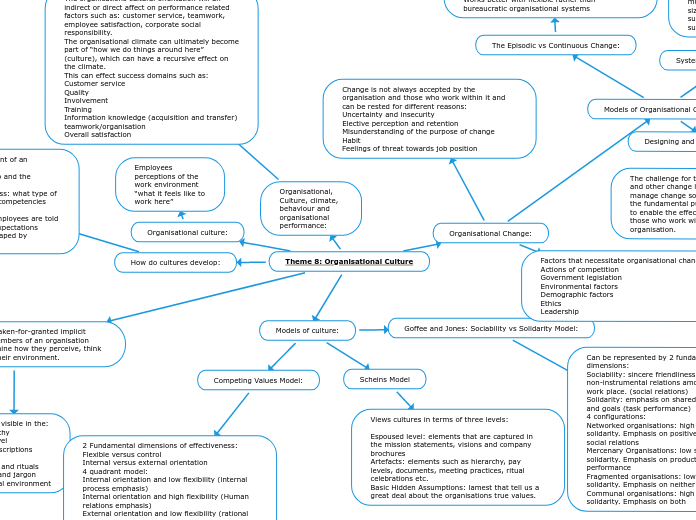Theme 8: Organisational Culture
Def: set of shared, taken-for-granted implicit assumptions that members of an organisation hold and that determine how they perceive, think about and react to their environment.
This is visible in the:
Hierarchy
Pay level
Job descriptions
Norms
Values and rituals
Jokes and jargon
Physical environment
Models of culture:
Scheins Model
Views cultures in terms of three levels:
Espoused level: elements that are captured in the mission statements, visions and company brochures
Artefacts: elements such as hierarchy, pay levels, documents, meeting practices, ritual celebrations etc.
Basic Hidden Assumptions: lamest that tell us a great deal about the organisations true values.
Goffee and Jones: Sociability vs Solidarity Model:
Can be represented by 2 fundamental dimensions:
Sociability: sincere friendliness or the emotional non-instrumental relations among friends in the work place. (social relations)
Solidarity: emphasis on shared common tasks and goals (task performance)
4 configurations:
Networked organisations: high sociability, low solidarity. Emphasis on positive feelings, good social relations
Mercenary Organisations: low sociability, high solidarity. Emphasis on productivity and performance
Fragmented organisations: low sociability, low solidarity. Emphasis on neither
Communal organisations: high sociability, high solidarity. Emphasis on both
Competing Values Model:
2 Fundamental dimensions of effectiveness:
Flexible versus control
Internal versus external orientation
4 quadrant model:
Internal orientation and low flexibility (internal process emphasis)
Internal orientation and high flexibility (Human relations emphasis)
External orientation and low flexibility (rational goal emphasis)
External orientation and high flexibility (Innovation)
How do cultures develop:
Factors that facilitate development of an organisations culture:
Leadership: what leaders say, do and the decisions they make
Recruitment and Selection Process: what type of people are recruited, with what competencies and characteristics
Socialisation processes: what employees are told about the organisation and its expectations
Globalisations: culture is also shaped by international cultures
Organisational culture:
Employees perceptions of the work environment “what it feels like to work here”
Organisational, Culture, climate, behaviour and organisational performance:
The organisations cultural orientation will an indirect or direct affect on performance related factors such as: customer service, teamwork, employee satisfaction, corporate social responsibility.
The organisational climate can ultimately become part of “how we do things around here” (culture), which can have a recursive effect on the climate.
This can effect success domains such as:
Customer service
Quality
Involvement
Training
Information knowledge (acquisition and transfer)
teamwork/organisation
Overall satisfaction
Organisational Change:
Factors that necessitate organisational change:
Actions of competition
Government legislation
Environmental factors
Demographic factors
Ethics
Leadership
Models of Organisational Change:
The Episodic vs Continuous Change:
Episodic (planned)
Planned and potentially revolutionary change
Aims to make lasting and fundamental changes
Change is usually big, noisy, and involves lots of time and money
Examples: restructurings, mergers, and acquisition
2. Continuous (emergent) change
Involves continuous (usually non-disruptive) improvements, encouraged by reflection and learning
Can be achieved by encouraging all to be agents of change
Works better with flexible rather than bureaucratic organisational systems
Systems Perspective to Change:
Anchored in the systems thinking.
This perspective fundamentally makes an assumption that organisations are composed of a multitude of subsystems that vary in shape in size and scope and that change in one subsystem will lead to change in other subsystems.
The Learning Perspective:
This perspective advocates for a pro-active approach to change and the creating of a culture within which learning happens continually at all levels
Two notions from this perspective:
Active Learning- proposes that organisations should continuously review their functioning, diagnose gaps, between current and desired performance, identify objectives for change, implement change, evaluate outcomes and the institutionalise the whole approach.
The Learning Organisation- works to create, acquire and transfer knowledge in order that the organisation adapts itself continually on the bias of now knowledge and insight, as well as to the external forces that influence survival.
Designing and implementing change:
The challenge for the leadership pf organisations and other change leaders is to understand and manage change so that it is shaped to support the fundamental purpose of the organisation and to enable the effectiveness and flourishing of those who work within and are served by the organisation.
Change is not always accepted by the organisation and those who work within it and can be rested for different reasons:
Uncertainty and insecurity
Elective perception and retention
Misunderstanding of the purpose of change
Habit
Feelings of threat towards job position
